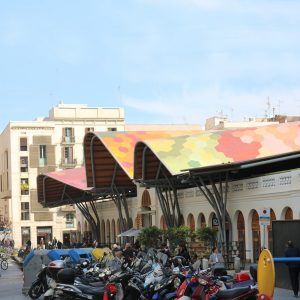Adaptive Reuse AIA Lecture: Above is a short video clip from our June 4, 2019 lecture titled “Repurposing Everyday Buildings: Extraordinary Renovations of Ordinary Structures” at the 2019 AIA Conference on Architecture in Las Vegas. Bea Spolidoro AIA and I talked about the advantages of adapting ordinary buildings to new uses. Here is a link to the lecture text highlights (if you have time for a bit of reading…) and here is the AIAU link to a video of the full lecture (which you can rent in order to obtain HSW learning units…)
First we talked in general about how and why buildings change. Then we introduced the concepts of restoration, preservation, and adaptive reuse. Next we honed in on “adaptive reuse” and traced its evolution into a self-conscious, deliberate strategy for preserving and enhancing old buildings.
Finally, we discussed ways that architects are now renovating ordinary buildings in extraordinary ways as they wrestle with the challenges of updating them to serve new functions.
For visitors something uncanny occurs when visitors experience the skilled adaptive reuse of an ordinary building: “Here complexity slows things down.” Because, as Sartre once wrote, we always project ourselves onto our surroundings, the best of these projects make up a new kind of vicarious human experience. At their best, they form an architecture that represents hope, hope that is borne from the successful resolution of past and present.1
These projects are experiential objects that disrupt daily life just enough to make one believe that there is more to our days than the humdrum.
Critics and creative, young architects used to reject adaptive reuse projects. Why? It used to be imagined that we could reinvent our profession with every line that we drew. This was an idealistic point of view for sure – good for us – but it was also willfully naive. Our belief is that Universities are not educating us to TRULY understand history because they are not teaching students how to relate to it with their designs. I review student portfolios all the time and have never seen an adaptive reuse project!
The reality is that architects ALWAYS must react with or against something: As the critic Alberto Perez has written, “There is no architectural ex-nihilo creation.”[2] (meaning out of nothing) This means that architecture is ALWAYS contextual. Far from limiting the solutions that architects (and students!) can create, preserving the past actually expands our vision by creating MORE variables to address, MORE problems to solve.
As the planet becomes filled with existing buildings, and resources become scarce, ordinary buildings are sure to be targeted more and more for adaptive reuse. Why is this? It’s because ordinary buildings lend themselves to the strategy: Adaptive reuse is a flexible, affordable, and sustainable alternative to demolishing ANY building and starting from scratch.
[1] “Obsolescence: An Architectural History” 2016 p. 115
[2] Architecture as Embodied Knowledge “Journal of Architectural Education” 1984
First we talked in general about how and why buildings change. Then we introduced the concepts of restoration, preservation, and adaptive reuse. Next we honed in on “adaptive reuse” and traced its evolution into a self-conscious, deliberate strategy for preserving and enhancing old buildings.
Finally, we discussed ways that architects are now renovating ordinary buildings in extraordinary ways as they wrestle with the challenges of updating them to serve new functions.
For visitors something uncanny occurs when visitors experience the skilled adaptive reuse of an ordinary building: “Here complexity slows things down.” Because, as Sartre once wrote, we always project ourselves onto our surroundings, the best of these projects make up a new kind of vicarious human experience. At their best, they form an architecture that represents hope, hope that is borne from the successful resolution of past and present.1
These projects are experiential objects that disrupt daily life just enough to make one believe that there is more to our days than the humdrum.
Critics and creative, young architects used to reject adaptive reuse projects. Why? It used to be imagined that we could reinvent our profession with every line that we drew. This was an idealistic point of view for sure – good for us – but it was also willfully naive. Our belief is that Universities are not educating us to TRULY understand history because they are not teaching students how to relate to it with their designs. I review student portfolios all the time and have never seen an adaptive reuse project!
The reality is that architects ALWAYS must react with or against something: As the critic Alberto Perez has written, “There is no architectural ex-nihilo creation.”[2] (meaning out of nothing) This means that architecture is ALWAYS contextual. Far from limiting the solutions that architects (and students!) can create, preserving the past actually expands our vision by creating MORE variables to address, MORE problems to solve.
As the planet becomes filled with existing buildings, and resources become scarce, ordinary buildings are sure to be targeted more and more for adaptive reuse. Why is this? It’s because ordinary buildings lend themselves to the strategy: Adaptive reuse is a flexible, affordable, and sustainable alternative to demolishing ANY building and starting from scratch.
[1] “Obsolescence: An Architectural History” 2016 p. 115
[2] Architecture as Embodied Knowledge “Journal of Architectural Education” 1984




